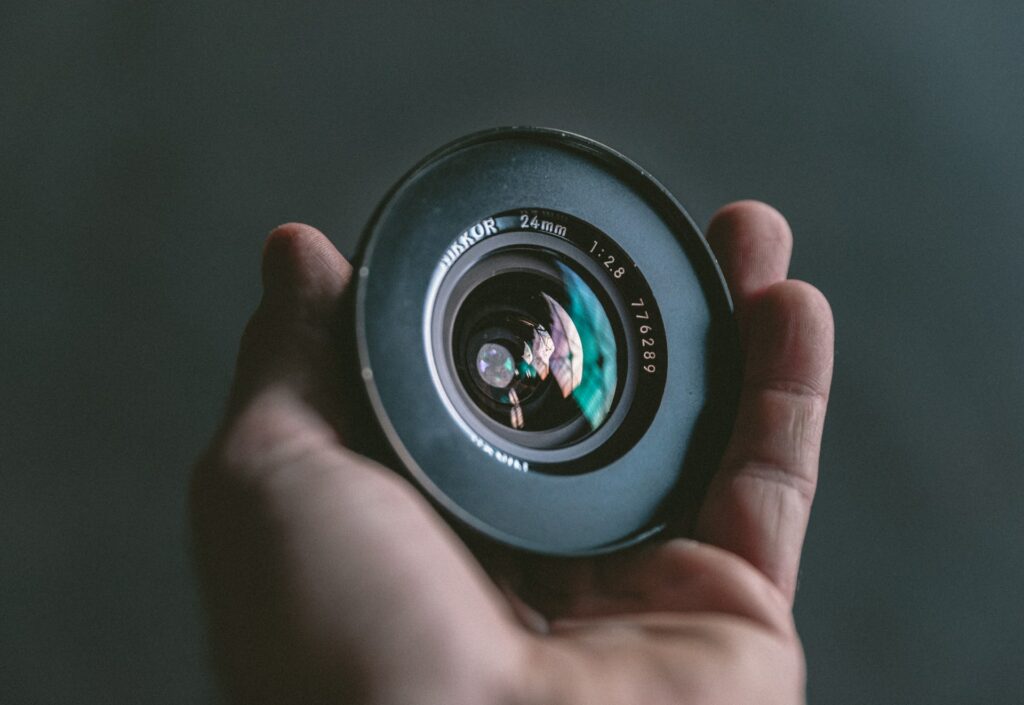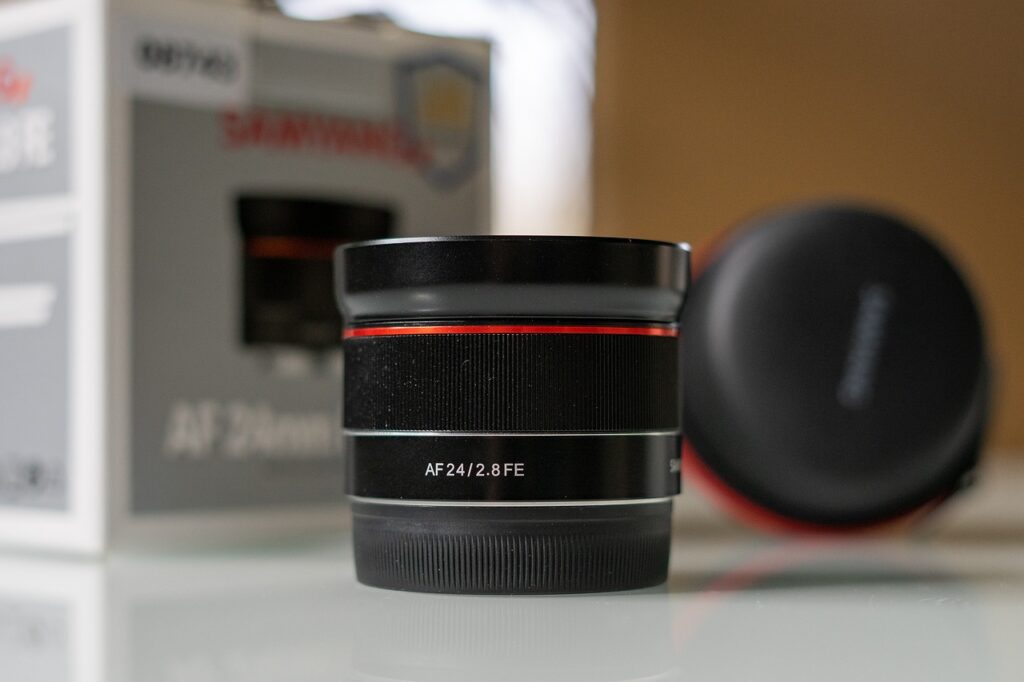
As an Amazon Associate we earn from qualifying purchases.
Although you can use 24mm and 35mm lenses for travel, wildlife, portrait, landscape, and real estate
Quick Navigation
Whether you are shooting wide-angle real estate exterior photos or interior photos in tight spaces, you will want a lens with a wide field of view that can capture the entire scene with minimal optical distortions.

Although both the 35mm and 24mm lenses can suit these applications, I will help you understand how their focal length difference affects their angle of view and overall performance and which lens might suit your circumstances best.
A 24mm lens is a lens with a focal length of 24mm when paired with a full-frame camera, an equivalent focal length of 38.4mm on a Canon APS-C camera with a crop factor of 1.6x and 36mm equivalent on other camera brands such as Sony, Nikon, and Fuji with a crop factor of 1.5x.
|
Brand:
Sony E-mount FE 24mm
|
Brand:
Nikon NIKKOR Z 24mm f/1
|
Brand:
Sigma 24mm f/1.4
|
|
Compatible Mountings:
Sony E
|
Compatible Mountings:
Nikon Z
|
Compatible Mountings:
Canon EF
|
|
Lens Type:
Wide Angle
|
Lens Type:
Wide Angle
|
Lens Type:
Wide Angle
|
|
Primary Rating:
4.7
|
Primary Rating:
4.6
|
Primary Rating:
4.4
|
A 35mm lens is a lens with a focal length of 35mm when paired with a full-frame camera and an equivalent normal perspective of 56mm on a Canon APS-C camera with a crop factor of 1.6x and 52.5mm equivalent on camera brands such as Sony, Nikon, and Fuji with a crop factor of 1.5x.
|
Brand:
Nikon AF-S 35mm f/1.8
|
Brand:
Canon EF 35mm f/2
|
Brand:
Sony FE 35mm f/1.8
|
|
Compatible Mountings:
Nikon F
|
Compatible Mountings:
Canon EF
|
Compatible Mountings:
Sony FE, Sony E
|
|
Lens Type:
Standard
|
Lens Type:
Wide Angle
|
Lens Type:
Wide Angle
|
|
Primary Rating:
4.7
|
Primary Rating:
4.7
|
Primary Rating:
4.7
|
Keeping in mind that lenses are considered wide-angle if they have focal lengths of 35mm and below, they are categorized as wide-angle and share some similarities. However, their focal lengths are different, affecting their suitability in certain situations.
Although there is a difference in the angle of view between these two lenses, both have short and fixed focal lengths, making them have the following similarities.
Although both 35mm and 24mm lenses are wide angles when paired with a full-frame camera, the focal length difference gives them the following field of view, depth of field, and image stability differences.
Depth of field is in focus and relatively sharp on a portion of an image. A deep depth of field is when the entire image from the foreground to the background is in focus. On the other hand, a shallow depth of field results in blurry elements in the foreground and background.
In most cases, portrait
The short focal length of the 24mm lens gives it a deeper depth of field, allowing you to get the main subject and the background in focus. On the other hand, the longer focal length of the 35mm lens gives it a shallower field depth, allowing you to blur the background.

Field of view, also known as angle of view, is the area a camera lens views at a given time. Generally, camera lenses are categorized depending on the angle of view, such as telephoto, normal, or even ultra-wide angle.
Lenses below 35mm are categorized as wide angles, while those below 16mm are categorized as ultra-wide angles. That means even if 35mm and 24mm are wide-angle lenses, the 24mm angle is wider than the 35mm and can capture a wider scene at the same subject distance.
For instance, the 24mm lens can capture the real estate interior of an entire room when shooting from the doorway. However, the wide-angle perspective creates optical distortions that might make the subject look deformed.
Generally, the lens size and weight depend on the construction materials, the barrel's length, and the lens's diameters, depending on whether it's designed for a full-frame or crop factor camera. Usually, a 35mm lens is larger and heavier due to the longer lens barrel.
The image shake effect is the blurriness that results from the camera shaking or the subject moving when the camera shutter is open. In most cases, this happens when using slower shutter speeds or shooting handheld.
Although the lens's focal length doesn't directly affect the shaking effect, it affects its magnification. Since a lens with a wider angle of view, like the 24mm lens for Sony captures a larger scene of nearby subjects, there is not much amplification of the camera shake as there is no zooming effect.
On the other hand, 35 mm lens for Sony has a narrower angle of view that creates a cropping effect that tends to fill the frame with a distant subject, creating a magnification effect. This magnification also magnifies the camera's movements or subject, causing more noticeable camera shakes than a 24mm lens.
The major distinguishing factor between a 24mm and 35mm lens is perspective compression, which is how objects in an image look closer or further from each other. Since the 24mm lens has a wider angle of view, it tends to expand the perspective and make the space between the subjects appear larger.
On the other hand, a 35mm lens has a narrower angle of view which constricts the perspective, making elements in the image look closer together. For instance, a room in a real estate interior photo might look more spacious when shot with a 24mm lens than when shot with a 35mm lens.

Keeping in mind that a 24mm lens has a shorter focal length and a wider field of view, it might be the best lens to use when shooting under the following conditions.
Since a 35mm lens has a narrower angle of view and can magnify distant subjects, it might be the best lens to use in the following
Although both lenses have a wide field of view when paired with a full-frame camera, the 35mm lens is a more versatile and better option as the focal length can change to an equivalent of a normal 50mm lens when paired with a crop-factor camera.
That means you can use this lens to shoot both wide and normal perspective photos depending on your camera.
Whether you want to take close-ups of tiny subjects with a crop-factor camera or wide-angle exterior real estate photos with a full-frame camera, the above 24mm vs 35mm guide helps you choose a lens that can suit your camera sensor size for the right perspective.
